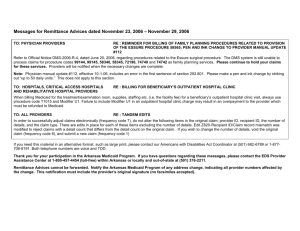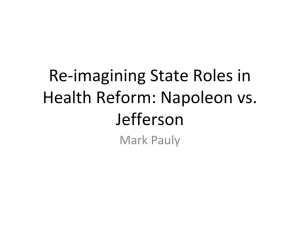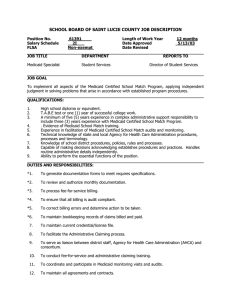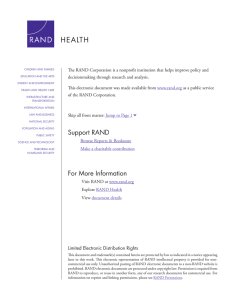✯ 2003 National Health Policy ... January 22-23, 2003 J.W. Marriott
advertisement
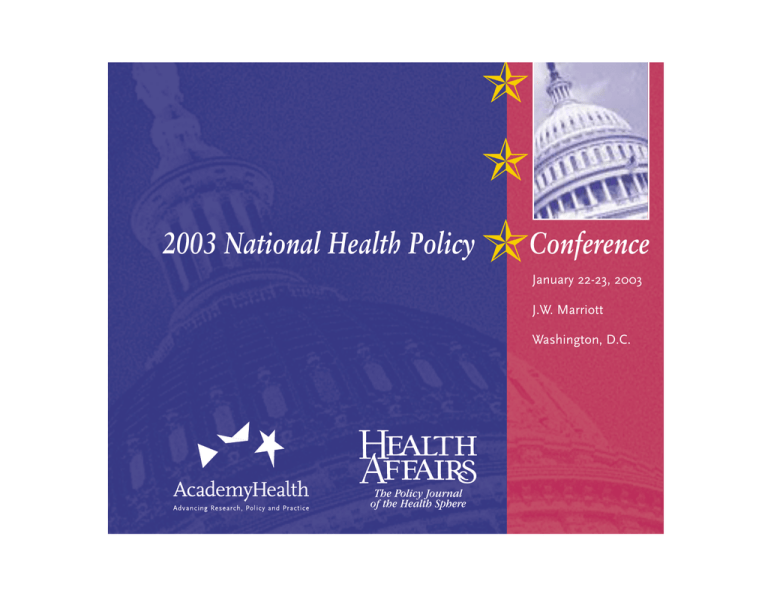
✯ ✯ 2003 National Health Policy ✯Conference January 22-23, 2003 J.W. Marriott Washington, D.C. Pharmacy Challenges: What Is the Right Prescription??? Prepared for National Health Policy Conference Ray Hanley Washington, DC January 23, 2003 Client Executive, EDS 501.374.6608 Drug spending surges Between 1990 and 1998, spending for prescription drugs far outstripped spending for hospital care and physician services. Drug spending now totals more than $90 billion a year. Percentage increase in spending 1990-1998 139.5% Hospital care 49.6% 57.5% Source: Health Care Financing Administration Physician services Prescription drugs In Addition, Medicaid Eligibility Has Grown Substantially… Medicaid Beneficiary Growth, Fiscal Years 1977-2001 45 40 (Millions) 35 30 Due largely to state expansion efforts and economic shortfalls, the number of Medicaid recipients has climbed to 44 million 25 20 15 1977 1981 1985 Source: HCFA 2082 data, Kaiser Family Foundation 1989 1993 1997 2001 Unlike commercial insurance, Medicaid covers the frailest, the sickest. Medicaid has no pre-existing–condition exclusions. Aging is a pre-existing condition… and the impact on Medicaid bears a very large price tag. Soaring drug costs are driving up employer health premiums. Do direct-to-consumer ads for Rx drugs cost Medicaid money? Washington Post March 29, 2002 “For the fourth straight year, prescription drug spending rose more than 17% in 2001, driven in large measure by a few heavily advertised, high priced medications.” -research from the nonpartisan National Institute for Health Care Management On the prospects of a new anti-obesity drug. . . “This is just what America needs. You go to McDonald’s, eat a Big Mac and pop a pill. No problem.” -Jean-Pierre Garnier, Glaxo CEO as reported by CBS MarketWatch, March 2001 No meaningful co-payment, no price sensitivity to name brand vs. generic Essential, in part, because regulations instill little cost sensitivity with Medicaid patients… Private-sector, tiered cost-sharing is not an option. States can do little if anything about drug prices in the short run without major federal action. Appropriately containing drug costs without forcing up other health care costs, navigating a sea of special interests, and finding the resources to get it done are huge challenges. Quality suffers if health care dollars support higher-than-necessary Medicaid drug expenditures. Various interests have different preferences for addressing the issues of cost and access. Like the drugs in question, most proposals have budgetary, political, and logistical side effects. Counter Detailing: A developing tool to help physicians make costeffective prescribing decisions. ¾Laminated cards showing differences in prices of drug choices ¾Letters to targeted physicians ¾Follow-up visits with doctors A Medicare drug benefit could free up many millions of dollars to address unmet Arkansas health care needs. The pharmaceutical companies have stepped up to help – but underutilized to date: ¾TOGETHERx ¾Share Card ¾Florida’s coming Common Application Technology is vital to managing Medicaid – in pharmacy especially. EDS’ Decision Support Systems in Arkansas and other states are making management possible. To manage the budget you have to know what you are buying and for whom. Arkansas has installed a software program in its claims processing system to ID patients abusing narcotics…with a $100,000 grant from Purdue Pharma, maker of OxyContin. Case study—drug therapy Baseline Recommendations • • • • • • • D/C Buspar, Seroquel, Ativan, and Propranolol • Decrease Zyprexa to 5 mg/day • Continue Depakote • Begin vitamin E • Vistaril prn agitation Buspar, 5mg tid Zyprexa, 10 mg qd Seroquel, 100 mg qd Depakote, 500 mg bid Propranolol, 10 mg tid Ativan, 1 mg prn Total, 6 drugs: $585/month Total, 4 drugs: $400/month After changes in drug therapy, patient was alert, pacing much less, less agitated, and not combative. Patient is eating better and allowing the staff to feed him. Asthma ¾40% of Arkansas children are insured though Medicaid/SCHIP. ¾Asthma is the leading cause of hospital admission and ER visits. ¾A prime candidate for partnership technology solutions If not for the many millions invested in R&D, what would be on the shelves or your corner store? For all of us in the health care industry, the future is filled with tough decisions and many challenges. And, in closing… Slippery slopes are ahead for healthcare. But if we didn’t like challenges, wouldn’t we all be elsewhere? Ray Hanley Client Executive, EDS 501.374.6608




